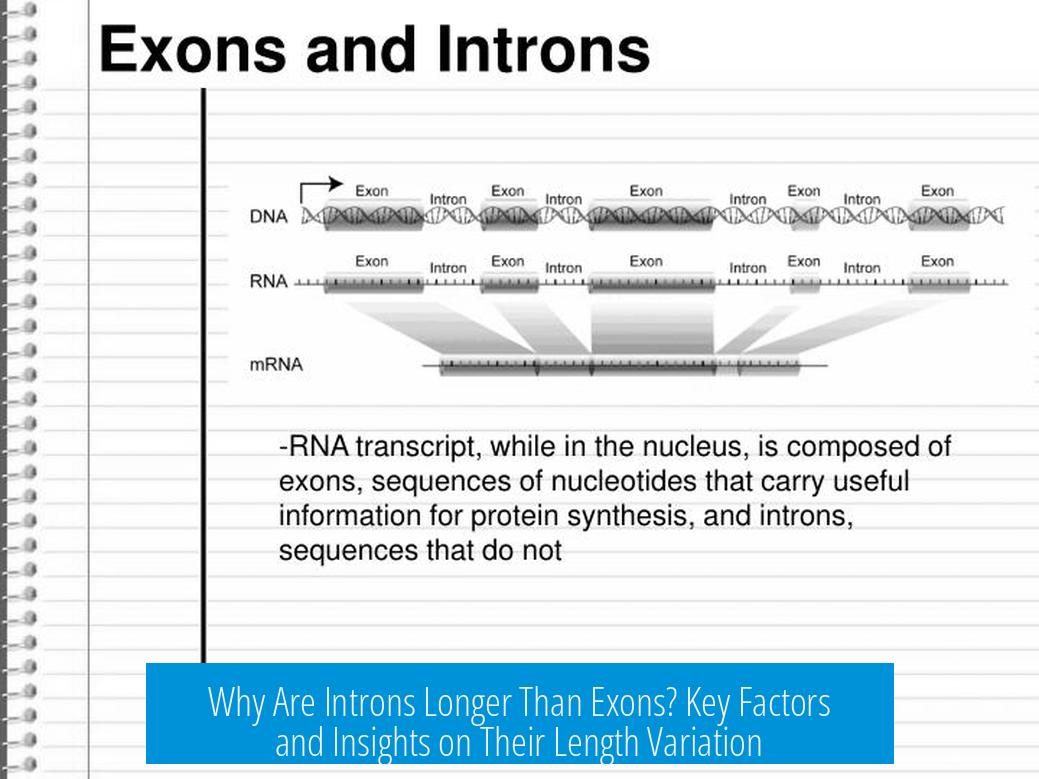Why Are Introns Longer Than Exons?
Introns are generally longer than exons due to a combination of evolutionary, genomic, and functional factors, especially in mammals. This pattern arises largely because of the large genome size and low gene density in these organisms, which permits extended intronic sequences without strong selective pressure against their length.
Variation of Intron Length Among Species
The length difference between introns and exons is not universal across all eukaryotes. In mammals, introns typically exceed exons in length. However, in many other eukaryotes, such as the nematode Caenorhabditis elegans, introns are often quite short. For example, about 75% of its introns range between 49 and 59 base pairs. Ciliates such as Paramecium tetraurelia possess even shorter introns. This suggests that the observed trend of longer introns is specific to organisms with larger, less compact genomes rather than a general eukaryotic feature.
- Mammals usually have longer introns.
- Some eukaryotes like nematodes and ciliates have very short introns.
- Length variability depends on evolutionary history and genome organization.
Genome Size and Spatial Constraints Influence Intron Length
Genome size has a direct effect on intron length. Humans and many mammals possess large genomes where protein-coding sequences make up a small percentage. The coding regions are interspersed sparsely by large stretches of non-coding DNA, including long introns. This genomic “space” allows introns to grow without interfering much with genome function or replication efficiency.
Conversely, organisms with compact genomes have very short intergenic regions and less room for long introns. For example, C. elegans and many unicellular eukaryotes have condensed genomes, forcing introns to remain short to maintain genomic efficiency. The intron length in these organisms is thus limited by spatial constraints and the selection pressure to keep genomes small and efficient.
| Genome Feature | Effect on Intron Length |
|---|---|
| Large genomes (e.g., humans) | Allow longer introns due to sparse gene distribution |
| Compact genomes (e.g., C. elegans, ciliates) | Restrict intron length to conserve space |
Functional Roles of Introns
Gene Regulation Elements Within Introns
Introns are not merely “junk” DNA but contribute to gene regulation. Many introns contain critical regulatory elements. For instance, promoter boxes and enhancer sequences often reside within intronic regions, directing when and where genes are expressed. This regulatory architecture allows cells to modulate gene activity precisely in response to developmental cues or environmental stimuli.
Post-Transcriptional and Alternative Splicing Functions
Beyond regulation at the transcriptional level, introns influence RNA processing after transcription. Introns provide the structural context required for splicing mechanisms. Alternative splicing, which produces different mRNA variants from a single gene, depends on intron-exon boundaries and intronic sequences. This process enhances protein diversity without increasing gene number.
Research shows introns contribute to post-transcriptional modifications and RNA maturation, adding complexity to gene expression outcomes.
Introns as Sources of Non-Coding RNA
Some introns encode small non-coding RNAs such as microRNAs (miRNAs). These small RNAs regulate gene expression post-transcriptionally, silencing or fine-tuning target mRNA translation. The presence of miRNA genes within introns adds another regulatory layer.
The study of intron-encoded small RNAs is ongoing and reveals a complex landscape of genome function beyond protein coding.
Evolutionary Footprint and Genomic Architecture
Introns represent an evolutionary legacy. Unlike prokaryotes, which have streamlined genomes with genes often arranged in operons, eukaryotic genomes have accumulated non-coding DNA through mutation and incomplete removal. DNA maintenance mechanisms are not always effective in eliminating non-functional sequences.
This leads to the persistence of introns and other “junk” sequences such as remnants of viral genes. These sequences contribute to genome size inflation and intron length variation, particularly in vertebrates.
Lack of Evolutionary Pressure Against Long Introns
In vertebrates, including humans, many introns are non-essential and serve no direct function. Unlike exons, which encode proteins under strong selective pressure to maintain sequence and length, non-functional intronic DNA faces weaker evolutionary constraints.
Because long introns do not necessarily impair survival or reproduction, they are tolerated and can accumulate over evolutionary time. Consequently, introns can become significantly longer than exons in these genomes.
Summary of Key Factors Determining Why Introns are Longer
- Species-Dependent Pattern: Introns tend to be longer than exons mainly in mammals, not universally across eukaryotes.
- Genome Size Impact: Large genomes with sparse coding regions permit longer introns; compact genomes restrict intron length.
- Functional Roles: Introns house regulatory elements and support alternative splicing and RNA-based regulation.
- Evolutionary History: Introns accumulate as genomic “footprints” of past insertions and mutations.
- Selective Pressure: Weak constraints allow long, non-functional introns to persist, especially in vertebrates.
Conclusion
The length disparity where introns exceed exons emerges from an interplay of genome architecture, gene regulation, evolutionary dynamics, and selective forces. Mammalian genomes illustrate how vast genomic “space” and limited functional constraints enable the existence of lengthy introns. Conversely, in organisms with compact genomes, introns remain short due to spatial and evolutionary pressures.
Introns serve critical roles beyond simply separating coding sequences. They contribute to gene control and transcript diversity while also embodying the genomic history of an organism. Understanding why introns are longer than exons provides insight into genome organization, molecular biology, and evolutionary biology.
Why are introns typically longer than exons in mammals?
Mammals have large genomes with sparse coding regions. This allows introns to be much longer since there is more non-coding space and fewer constraints on intron length compared to exons.
Do all eukaryotes have longer introns than exons?
No. In some eukaryotes like nematodes and ciliates, introns are very short. The pattern of long introns mainly applies to mammals with large, less compact genomes.
What functional roles do longer introns play?
- They contain regulatory elements needed for gene expression control.
- They aid in alternative splicing and post-transcriptional modifications.
- Some also encode small non-coding RNAs like miRNAs that regulate gene activity further.
Could intron length be due to evolutionary remnants?
Yes. Many introns may be non-functional sequences retained because there is little evolutionary pressure to remove them. This allows introns to accumulate and grow longer over time.
Why do organisms with compact genomes have short introns?
In compact genomes, space is limited. Genes and their surrounding regions are closely packed, so introns cannot be very long without disrupting genome structure.





Leave a Comment